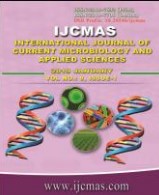


 National Academy of Agricultural Sciences (NAAS)
National Academy of Agricultural Sciences (NAAS)

|
PRINT ISSN : 2319-7692
Online ISSN : 2319-7706 Issues : 12 per year Publisher : Excellent Publishers Email : editorijcmas@gmail.com / submit@ijcmas.com Editor-in-chief: Dr.M.Prakash Index Copernicus ICV 2018: 95.39 NAAS RATING 2020: 5.38 |
The present study was aimed to do comparative evaluation of efficacy of various staining techniques and rapid diagnostic tests used for identifying the Plasmodium falciparum parasite, to determine sensitivity and specificity of rapid diagnostic methods and compare the results of rapid diagnostic methods with conventional microscopy. Total of 107 male and female febrile patients of all age, clinically suspected to be positive for malaria, willing to participate and to sign the informed consent form were included in this study. Smears were stained by Leishman, Geimsa and JSB and antigen detection is done b by rapid test. Among the 107 clinically suspected cases, Leishman stain detected 18(16.8%) P.falciparum. Geimsa stain detected 16(14.9%) P.falciparum. JSB stain detected 15(14%) P.falciparum. RDT was positive for P.falciparum 18(16.8%) cases. In comparison to Leishman stain as gold standard the sensitivity, specificity, PPV and NPV of Geimsa, JSB and RDTs for P. falciparum were 88.8%, 100%, 100%, 97.8%, 83.3%, 100%, 100%, 96.7%, 55.5%, 91%, 55.5% and 91% respectively. Antigen based (HRP-2) RDTs are as specific as conventional microscopy but less sensitive. Their performance is highly affected by parasite density calling for further evaluation before incorporating them as diagnostic tools in peripheral health service. It is also understood that RDTs can be used only in conjunction with microscopy to improve the diagnosis of malaria.
 |
 |
 |
 |
 |